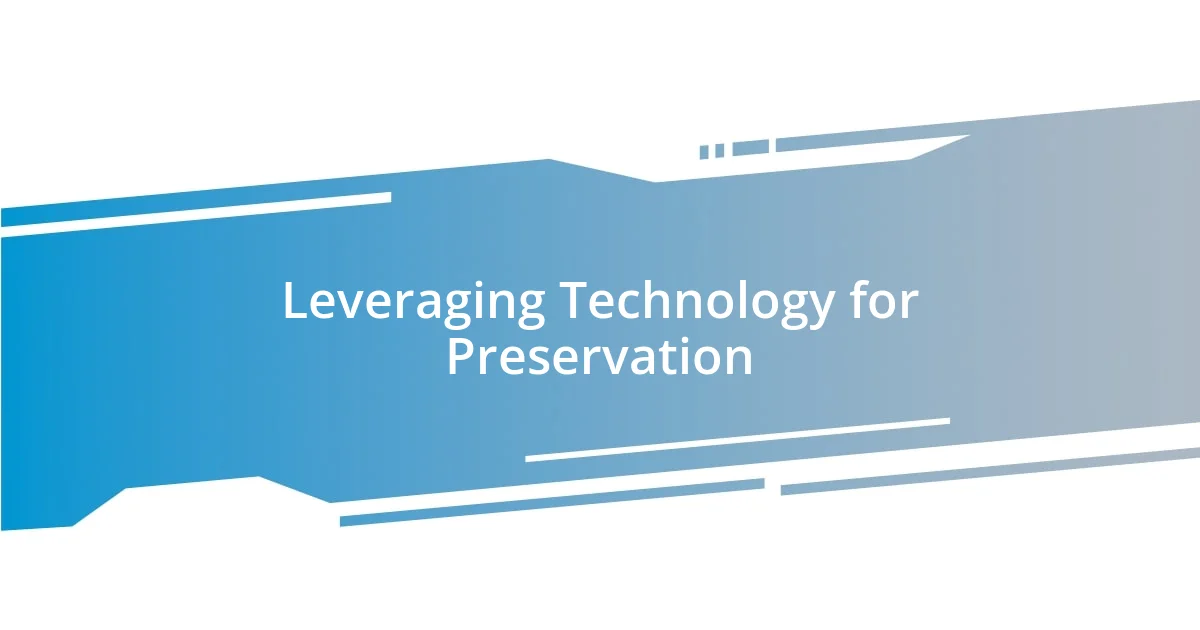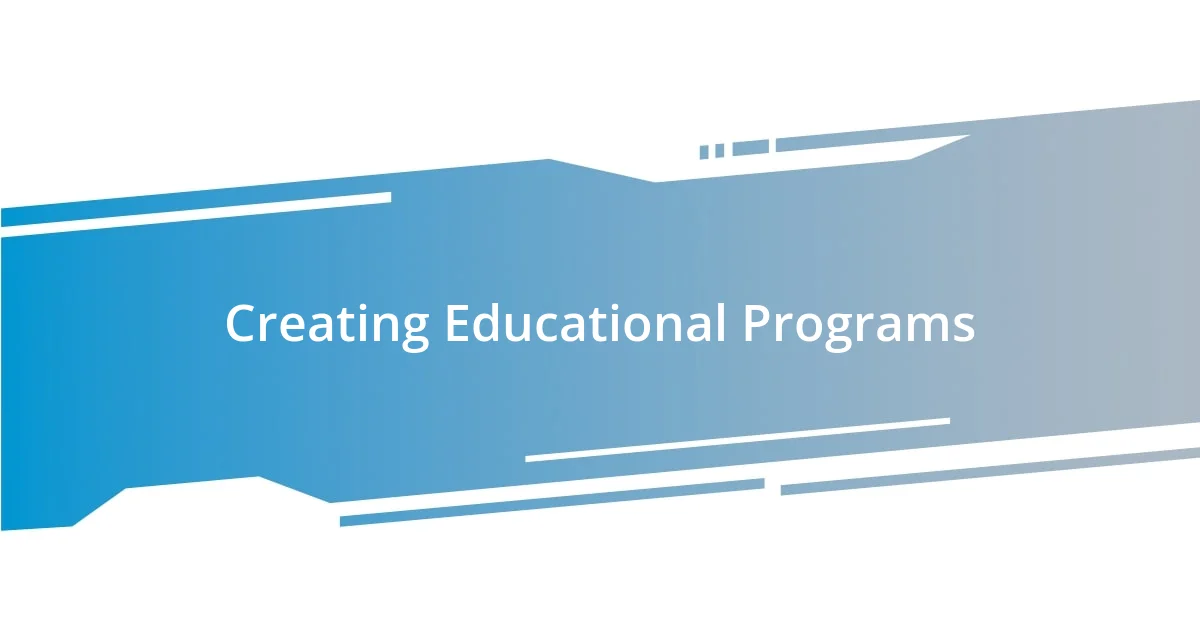Key takeaways:
- Heritage preservation is essential for maintaining cultural identities and passing down stories to future generations.
- Community engagement and participation in preservation efforts enhance connections and foster a sense of belonging.
- Utilizing sustainable practices and modern technology can significantly improve the effectiveness of heritage preservation initiatives.

Understanding Heritage Preservation
Heritage preservation is more than just maintaining old buildings or artifacts; it’s about safeguarding the stories and values that shape our identities. I remember wandering through a dilapidated church in my hometown, standing in awe of its stained glass windows that whispered tales from generations past. Have you ever felt a connection to a place that seemed to breathe history?
The true essence of heritage preservation lies in recognizing its importance for future generations. I often think about my niece as she enthusiastically listens to family stories during gatherings, her eyes sparkling with curiosity. What will her children learn about their roots if we don’t protect and celebrate these remnants of our past?
Additionally, the emotional weight of preserving heritage cannot be overstated. I recall the bittersweet moment when my grandmother’s home was being restored; every cracked wall and worn-out floorboard told a story. Doesn’t it make you ponder how the spaces we inhabit hold the key to understanding who we are? Each piece of heritage preservation, big or small, contributes to a collective memory that binds us together.

Identifying Heritage to Preserve
Identifying what heritage to preserve often hinges on personal connections and the narratives that resonate with us. I once stumbled upon a small community museum while visiting a neighboring town, filled with artifacts from local artisans. Each piece sparked memories of my childhood where stories of craftsmanship and community pride were passed down, making me realize how crucial it is to safeguard these tangible stories.
As I reflect upon what I consider worth preserving, I think about the values and traditions that have shaped my upbringing. For instance, my family’s annual cultural festival not only celebrates our heritage but also reinforces our bonds. Have you ever experienced an event that made you feel deeply connected to your roots? Identifying heritage goes beyond the physical; it’s about those moments that imbue our lives with meaning and a sense of belonging.
When considering heritage, I’ve learned to appreciate the diversity of perspectives within my community. A neighbor once shared her family’s history, rich with tales of resilience and adaptation. This conversation opened my eyes to the importance of preserving not just my own heritage but also those narratives that enrich the fabric of our shared experience. In essence, every story holds a piece of our collective identity, illuminating the paths we’ve walked.
| Preservation Factors | Personal Connection |
|---|---|
| Historical Significance | Community Relevance |

Engaging the Community
Engaging the community is vital for effective heritage preservation. I vividly recall attending a local workshop where neighbors shared their memories and experiences tied to our heritage sites. These discussions not only fostered a sense of belonging but also revealed the hidden treasures within our collective past. Have you ever noticed how a shared story can create bonds that endure through generations?
To enhance community involvement, organizations can consider these strategies:
- Host Local Events: Organize heritage festivals, workshops, or storytelling nights to draw people in.
- Create Collaborative Projects: Encourage residents to contribute to the preservation of sites that resonate with them.
- Leverage Social Media: Use platforms to share stories and engage younger audiences in the importance of heritage.
- Establish Heritage Groups: Form local committees that focus on conservation efforts and promote awareness.
- Collect Oral Histories: Gather narratives from older community members, preserving their insights for future generations.
By taking these steps, we can cultivate a deeper connection among individuals and foster a community unified by its shared history.

Utilizing Sustainable Practices
Utilizing sustainable practices in heritage preservation is not just a choice—it’s a necessity. I remember a project where we repurposed old materials from nearby historical buildings to create community art installations. It was fascinating to see how using reclaimed wood and bricks not only honored the original structures but also provided a sustainable way to breathe new life into our space. Have you ever thought about how many stories old materials can carry along with their physical presence?
Moreover, I find it deeply rewarding to engage in eco-friendly methods when preserving cultural artifacts. For instance, during a recent preservation effort at a local site, we opted for natural cleaning products and biodegradable materials to ensure that our actions aligned with environmental values. The satisfaction of working in a way that respects both heritage and nature was incredibly fulfilling. Isn’t it empowering to know that our choices today can safeguard both the past and the planet for future generations?
Additionally, I often think about the role of technology in promoting sustainable practices. Utilizing digital archiving has become a game changer for preservation efforts. By creating virtual repositories and using 3D modeling for endangered sites, we can preserve their essence without causing physical deterioration. I still recall sharing the excitement of a virtual tour with friends who had never visited these sites, allowing them to connect with our heritage in a sustainable way. How can we leverage these modern tools to keep our history alive while respecting our environment?

Leveraging Technology for Preservation
When it comes to leveraging technology for preservation, I often think about how digital platforms transform our approach. A few months ago, I stumbled upon a software that helps create detailed 3D scans of historical artifacts. This not only brings these pieces to life online but also makes them accessible to those who may never have the chance to see them up close. Have you considered how virtual experiences can open doors to our heritage for people across the globe?
Moreover, I’ve had the chance to participate in a fascinating initiative that used augmented reality (AR) to bring historical sites back to life. Watching as visitors donned AR glasses to see previous iterations of a long-lost building filled me with awe. It was extraordinary to witness their reactions—people were genuinely transported to another time! How powerful it is that technology can stir emotions and deepen our understanding of history in such a vivid manner!
Finally, I can’t help but reflect on the potential of social media in heritage preservation. Just last week, I saw a local museum use Instagram Stories to share the restoration process of a cherished artifact. For me, this not only educated their audience but also generated excitement and support for their work. Have you ever joined an online community that felt like an extension of your own backyard, where you could come together to cherish shared history? It’s in these digital spaces that our past can live and breathe anew, connecting us all in ways we’d never imagined before.

Creating Educational Programs
Creating educational programs around heritage preservation is a rewarding endeavor for me. I remember one workshop where I invited local students to explore their community’s history through storytelling. Watching their faces light up as they uncovered forgotten tales reminded me how vital it is to pass down knowledge. Have you ever felt the thrill of discovering a hidden gem from your own background?
In another project, I worked with a team to develop an interactive curriculum that blended art and history. We encouraged students to create their own heritage-inspired artworks, which they later showcased in a local exhibit. The pride on their faces as they explained the significance of their creations was heartwarming. It’s fascinating how art can serve as a bridge, connecting young minds to their cultural roots. What if we nurtured this kind of creativity in every classroom?
I also advocate for community involvement in these programs. During a recent event, we collaborated with elders who shared their life stories and traditions. The air was filled with laughter and nostalgia, leaving both the participants and storytellers moved by the experience. How do you think firsthand accounts can deepen our understanding of heritage? These exchanges not only preserve history but also foster empathy and connection, enriching our collective narrative.

Measuring Success in Preservation
Measuring success in heritage preservation can sometimes feel elusive, but I believe it’s about the connections we forge. For instance, during a recent project assessing the impact of a local restoration, we gathered feedback from community members who shared heartfelt stories about what the site meant to them. Seeing how a simple preservation effort sparked joy and nostalgia in people’s lives illuminated for me the true measure of success—it’s not just the bricks and mortar, but the memories and emotions tied to them.
In my experience, tangible outcomes like increased visitation numbers or positive media coverage can be indicators of success. However, I found that a more personal metric lies in the stories we gather. After hosting a preservation workshop, I was moved by participants who opened up about their familial ties to the preserved heritage. One participant even shared a cherished family recipe passed down through generations, which connected their culinary culture to the physical space we worked on. This reminded me that every successful preservation effort should cultivate a deeper sense of belonging and identity within the community.
Lastly, I’ve learned that successful preservation often involves continuous engagement with the audience. A few months back, I organized a follow-up event with the community to discuss ongoing efforts and solicit feedback. The lively discussions and shared insights created a sense of ownership among attendees. It’s fascinating to witness how preservation evolves through these dialogues, reinforcing my belief that measuring success isn’t merely a checklist—it’s about nurturing relationships that keep heritage alive for future generations. Wouldn’t you agree that our shared stories are what truly breathe life into history?














